In the digital age, where every click, scroll, and tap can be meticulously tracked and analyzed, email remains an incredibly powerful tool for businesses and marketers. It’s personal, direct, and when executed correctly, can yield a significant ROI. But how can organizations ensure that their email campaigns are performing at their optimum? The answer lies in email analytics.
The need to stay on top of campaign performance isn’t just a “nice-to-have”; it’s an essential component of maintaining a robust digital strategy. Email analytics provides a treasure trove of data, illuminating how subscribers interact with campaigns, and revealing avenues for optimization. As we delve into this comprehensive guide, we’ll uncover the intricacies of email analytics, the metrics that matter, and the strategies to supercharge email campaign performance.
Drawing from my experience, we’ve found that infusing personalized content, captivating subject lines, and strategic segmentation within our email marketing software yields remarkable results. A/B testing, tailored graphics, and compelling CTAs have proven invaluable in refining our approach.
John Chandler
SEO Consultant- Fluent Slang
Understanding Email Analytics
Email analytics refers to the detailed tracking and analysis of email campaign performance. It involves collecting data from emails sent to subscribers and prospects, and then leveraging that data to refine and improve subsequent campaigns. By analyzing key metrics, marketers can glean insights into subscriber behavior, content preferences, and the overall efficacy of their email strategies.
Why Email Analytics is Essential for Marketers
Email isn’t just a communication tool; it’s a window into the preferences, behaviors, and desires of your audience. With billions of emails sent daily, those not leveraging analytics are essentially flying blind, missing out on invaluable insights and opportunities for refinement.
Here’s the clincher: Email has a median ROI of 122% – over four times higher than other marketing formats, including social media, direct mail, and paid search. This statistic underscores the potential of well-executed email campaigns and the importance of analytics in realizing that potential.
“I regularly review my email analytics to see what content resonates. I tweak my subject lines, send times, and lists based on open and click through rates. I also survey subscribers to get direct feedback on how I can improve.“
Matthew Hannah Anderson
Founder, IT | Random Timer
Brief Overview of Key Performance Indicators (KPIs) in Email Campaigns
At its core, KPIs in email campaigns serve as a compass, guiding marketers towards their goals and highlighting areas that require attention. These indicators range from open rates to conversion rates, each shedding light on a specific facet of campaign performance. As we progress, we’ll delve deeper into each KPI, elucidating its importance and offering strategies for optimization.
Key Metrics Measured by Email Analytics Tools
#1. Open Rate
The open rate represents the percentage of recipients who opened an email relative to the total number of emails sent. It’s one of the most fundamental metrics in email analytics, serving as a preliminary indicator of campaign success.
At a glance, the open rate reveals how compelling your subject line was and how well you’ve built trust with your audience. A consistent low open rate may signal a disconnect with the target audience or potential deliverability issues.
Factors Influencing Open Rates
Several elements play a role in determining open rates:
- Subject Line: It’s the first thing recipients see. An engaging subject line piques curiosity, urging the recipient to open the email.
- Sender Reputation: If previous interactions with your brand were positive, recipients are more likely to open subsequent emails.
- Timing: The day and time an email is sent can impact its open rate. While there’s no universal “best time,” understanding your audience’s habits can guide your scheduling decisions.
My go-to email marketing software is Mailshake, renowned for its effective campaign management capabilities and user-friendly design. Mailshake effortlessly integrates with my workflow, enabling efficient client interaction and providing valuable data insights that help me craft personalized email strategies.
Marshal Davis
President- Ascendly Marketing
Benchmarking Open Rates
Benchmarking involves comparing your open rates to industry standards. Factors such as your industry, the type of email (e.g., newsletter vs. promotional), and your audience’s demographics can influence these benchmarks. For instance, a B2B company might have different benchmarks than a B2C e-commerce store. By understanding where you stand in relation to your peers, you can set realistic goals and aspirations for improvement.
#2. Click-Through Rate (CTR)
Click-through rate gauges the percentage of email recipients who clicked on one or more links contained in an email. This metric provides a deeper dive into recipient engagement beyond just opening the email.
For businesses, a high CTR indicates resonating content that prompts action. Conversely, a low CTR might hint at content misalignment or lackluster call-to-actions.
Relation to Email Content and Design
The content and design of an email directly impact its CTR. A well-designed email with clear, compelling content can drive higher engagement. Key considerations include:
- Relevant Content: Ensure the content addresses the recipients’ needs or interests.
- Clear CTAs: Buttons or links should be noticeable and convey a clear action, e.g., “Shop Now” or “Learn More.”
- Uncluttered Design: An overcrowded email can confuse recipients. Use white space strategically to guide the reader’s eyes.
Strategies to Improve CTR
- Segment Your List: Deliver tailored content to specific audience segments.
- A/B Test Different Elements: Test variations of CTAs, content, and design to determine what resonates most.
- Use Persuasive Language: Actionable verbs and urgency can prompt clicks.
I use MailChimp for its robust features and user-friendly interface. It provides great automation, segmentation, and analytics. I prefer it for its flexible design and A/B testing capabilities. To enhance KPIs, I fine-tune email campaigns by segmenting my audience, personalizing subject lines, and optimizing send times based on user data. A/B testing is vital for improving open rates and CTR. Remember, effective email marketing is about understanding and engaging your audience.
June Escalada
Business Manager- PhotoshopBUZZ
#3. Bounce Rate
The bounce rate measures the percentage of emails that weren’t delivered to the recipient’s inbox. When emails “bounce,” they’re essentially returned to the sender for various reasons. Bounces can be classified into two main categories:
- Hard Bounces: This is when the email is permanently rejected either because the domain doesn’t exist or the recipient’s address is invalid. It’s crucial for senders to remove hard bounced addresses immediately from their list to maintain email deliverability reputation.
- Soft Bounces: These are temporary delivery failures. They can occur due to a recipient’s mailbox being full, the email server being temporarily down, or the email size being too large. Unlike hard bounces, these addresses can be retried after addressing the specific issue.
Regular reflection and list maintenance fortify our subscriber base, ultimately driving enhanced campaign outcomes and fostering meaningful connections with our audience.
John Chandler
SEO Consultant- Emoji Sprout
How to Reduce Bounce Rates?
- Regular List Cleaning: Regularly remove inactive subscribers and addresses that result in hard bounces. This ensures you’re only sending to valid and engaged recipients.
- Email Verification Tools: Before adding new addresses to your list, use verification tools to validate the authenticity of email addresses. This step can significantly reduce the chances of hard bounces.
- Avoid Spam Triggers: Ensuring your emails don’t come across as spam can help bypass strict server filters. Avoid excessive use of capital letters, spammy words like “free,” or exclamation points.
#4. Conversion Rate
Tracking Conversions from Email Campaigns
The conversion rate from email campaigns refers to the percentage of recipients who took a desired action after clicking on a link within the email. This action can range from making a purchase to signing up for a webinar.
For business leaders, understanding conversion rates is crucial. A high CTR with a low conversion rate might suggest a disconnect between the email content and the landing page or offer.
Importance of Aligning Email CTA with Landing Pages
Consistency is king. If your email promotes a 20% discount, but the landing page displays a 10% discount, this discrepancy can confuse visitors and reduce trust. Ensure that what you promise or advertise in the email aligns seamlessly with what’s delivered on the landing page.
#5. Unsubscribe Rate
Monitoring and Understanding Spikes in Unsubscribes
The unsubscribe rate represents the percentage of recipients who opt out of your email list after receiving an email. While some level of churn is normal, sudden spikes can be alarming.
For startups and C-level executives, a rising unsubscribe rate could signify:
- Over-sending: Too many emails can overwhelm subscribers.
- Irrelevant Content: If the content isn’t resonating or meeting subscriber expectations, they might opt out.
- Lack of Personalization: Generic, non-tailored emails might not appeal to everyone.
Strategies to Minimize Unsubscribe Rates
- Segmentation: Delivering targeted content based on subscriber preferences or behavior can keep the content relevant.
- Frequency Options: Allow subscribers to choose how often they wish to hear from you, giving them control over their inbox.
- Feedback Loop: When someone opts to unsubscribe, offer a quick feedback option. Understanding their reasons can provide valuable insights.
#6. List Growth Rate
Importance of Expanding Your Email List
A growing email list signifies a broader audience, which, in turn, represents increased opportunities for engagement, sales, and brand advocacy. For startups and seasoned businesses alike, the email list growth rate can be a barometer of brand health and audience interest.
Tactics for Organic List Growth
- Content Upgrades: Offering valuable content like e-books, checklists, or webinars in exchange for email sign-ups can attract genuinely interested subscribers.
- Website Optimization: Incorporate easily accessible and prominent sign-up forms on your website, particularly on high-traffic pages.
- Leverage Social Media: Promote sign-up incentives on your social platforms, encouraging your followers to join your email list.
- Host Webinars or Events: These can act as platforms to attract industry-specific subscribers, offering value and networking opportunities in return for their email.
#7. Email Sharing/Forwarding Rate
Importance of Viral Emails
Emails that recipients deem share-worthy are golden. When your email content resonates so deeply that subscribers willingly share it with their network, it amplifies your brand’s reach and credibility without extra marketing dollars.
Strategies to Encourage Sharing
- Include Share Buttons: Make it easy for recipients to share your email content on their social media or forward it to a friend with a simple click.
- Create Shareable Content: Whether it’s an insightful infographic, an exclusive offer, or a heartwarming story, content that evokes emotion or provides value is more likely to be shared.
- Incentivize Sharing: Offer discounts, giveaways, or exclusive content to those who share your emails.
The Role of Segmentation in Enhancing Email Performance
What is Segmentation?
At its core, segmentation is the division of your email list into smaller, more specific groups based on certain criteria, such as demographics, purchase behavior, or engagement levels. This enables tailored communication, enhancing relevance for the recipient.
Benefits of Segmentation
Targeted Content: By understanding the nuances of each segment, businesses can deliver content that resonates, resulting in better engagement and ROI.
Higher Engagement Rates: When emails reflect the interests or needs of the recipient, they’re more likely to be opened, read, and acted upon.
Segmentation Strategies
Demographic Segmentation: This involves dividing your list based on criteria like age, gender, location, or occupation. For instance, a fashion brand might send different product recommendations to male and female segments.
Behavioral Segmentation: This takes into account actions like past purchases, website visits, or cart abandonments. A startup might target users who abandoned their cart with a special discount to prompt a purchase.
Lifecycle Stage Segmentation: Whether a subscriber is a new sign-up, a loyal customer, or somewhere in between, tailoring emails to their stage in the customer journey can be highly effective.
Tools and Platforms for Email Analytics Tools Help Measuring and Boosting Campaign Performance
#1. Mailchimp

Features:
- Audience Segmentation: Create targeted segments for campaigns.
- A/B Testing: Test subject lines, content, send times, and more.
- Performance Reports: Track open, click-through, bounce rates, and ROI.
Pricing:
- Free Plan: Up to 2,000 contacts and 10,000 sends per month.
- Essentials: Starts at $9.99/month.
- Premium: Starts at $299/month.
Pros:
- User-friendly platform ideal for beginners.
- Rich template library.
- Extensive integration capabilities.
Cons:
- Advanced analytics only available in higher-tier plans.
- Can become expensive as the subscriber list grows.
We use Mailchimp to create and send personalized email campaigns to our segmented audience. The software allows us to automate email sequences based on customer behavior and engagement.
David Cohen
CEO- Badais International
#2. SendinBlue
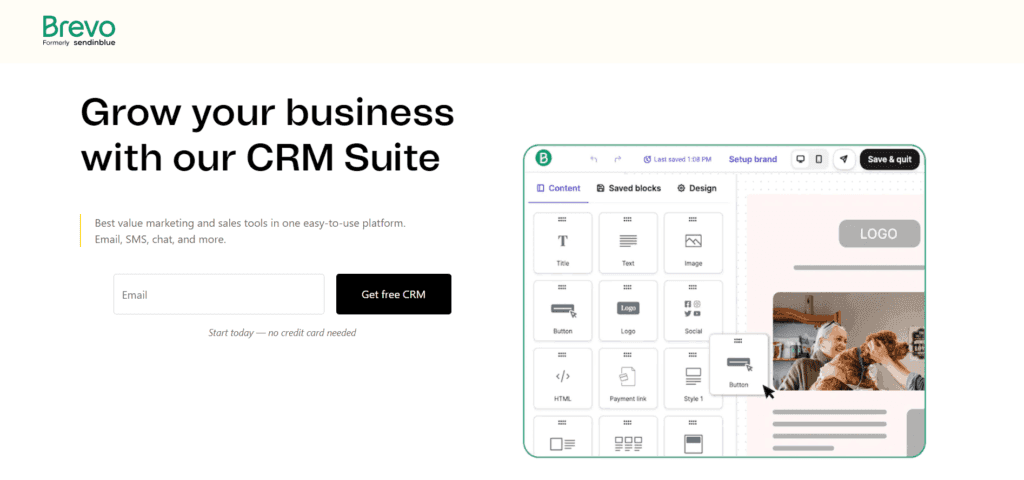
Features:
- Heat Mapping: Visualize where subscribers are clicking.
- Real-Time Reporting: Monitor campaign performance as emails are opened and interacted with.
- Geographical Tracking: See where subscribers are located globally.
Pricing:
- Free: 300 emails/day.
- Lite: $25/month for 40,000 emails.
- Premium: $65/month for 120,000 emails.
Pros:
- A scalable pricing model.
- SMS integration for extended marketing.
- Intuitive drag-and-drop editor.
Cons:
- Limited integrations compared to competitors.
- Learning curve for some advanced features.
#3. Campaign Monitor
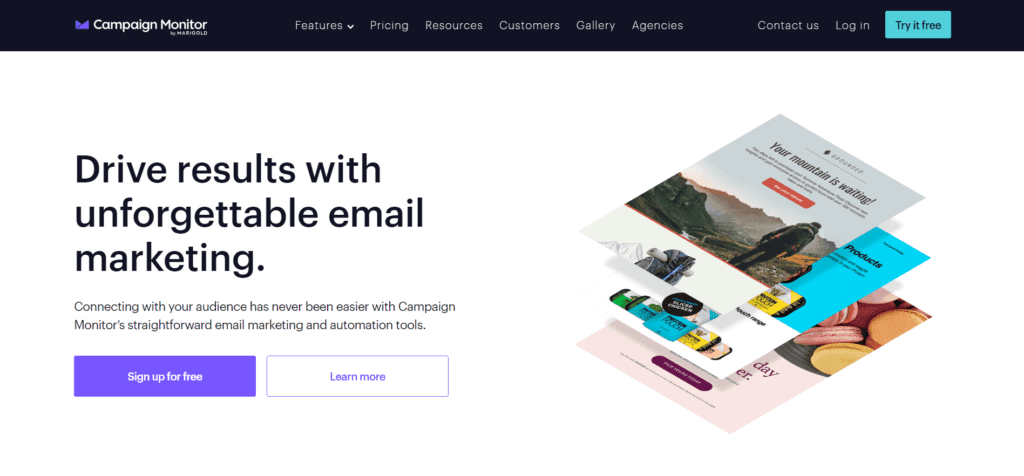
Features:
- Visual Journey Designer: Craft targeted email campaigns.
- Engagement Segmentation: Segregate audience based on how they interact with emails.
- Unsubscribed Tracking: Understand why subscribers opt out.
Pricing:
- Basic: $9/month for 2,500 emails.
- Unlimited: $29/month for unlimited emails.
- Premier: $149/month for advanced features.
Pros:
- Clean, user-friendly UI.
- Comprehensive list management tools.
- Personalization capabilities.
Cons:
- Some features restricted to Premier plan.
- Limited third-party integrations.
#4. GetResponse
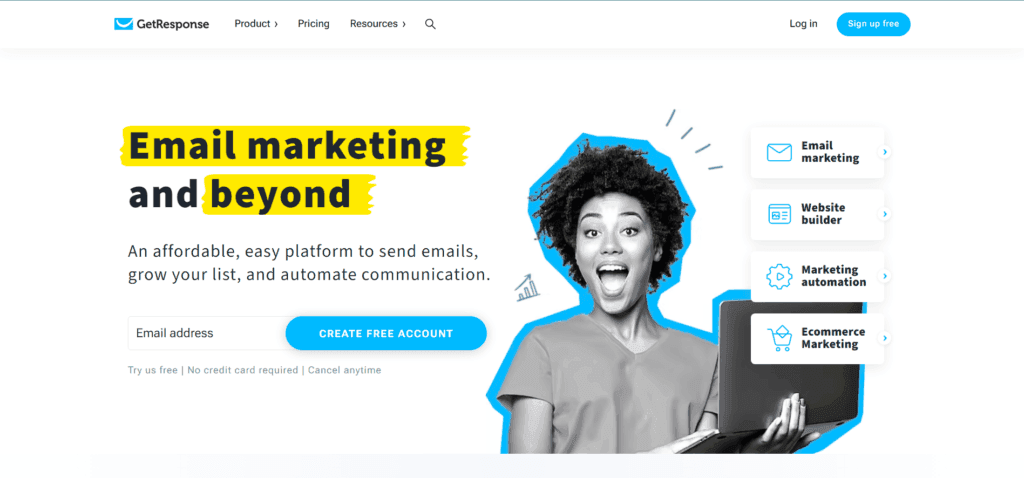
Features:
- Email ROI Analysis: Measure the profitability of your campaigns.
- Autoresponder Analytics: Monitor and optimize automated email sequences.
- E-commerce Integration: Track sales directly from emails.
Pricing:
- Basic: $15/month.
- Plus: $49/month.
- Professional: $99/month.
Pros:
- Versatile platform with e-commerce capabilities.
- Landing page and webinar tools integrated.
- Comprehensive automation options.
Cons:
- Advanced analytics features can be complex for beginners.
- Some users find the design templates limiting.
#5. Litmus

Features:
- Pre-send Testing: Ensure emails display correctly across devices.
- Engagement Analytics: Dive deep into how subscribers interact with content.
- Spam Testing: Check if your emails land in the inbox or spam.
Pricing:
- Basic: $99/month.
- Plus: $199/month.
- Enterprise: Custom pricing.
Pros:
- Comprehensive testing capabilities.
- Integration with major email service providers.
- Collaborative tools for teams.
Cons:
- Expensive for small businesses.
- UI can be overwhelming initially.
#6. Constant Contact

Features:
- Action Blocks: Add RSVP, polls, and more directly into emails.
- Click Segmentation: Create lists based on what links subscribers click.
- Email Heat Tracking: See what parts of the email are most engaging.
Pricing:
- Email: Starting at $20/month.
- Email Plus: Starting at $45/month.
Pros:
- Intuitive interface ideal for those new to email marketing.
- Extensive template options.
- Rich educational resources and community support.
Cons:
- Limited advanced analytics features.
- Higher pricing compared to some competitors.
#7. ActiveCampaign
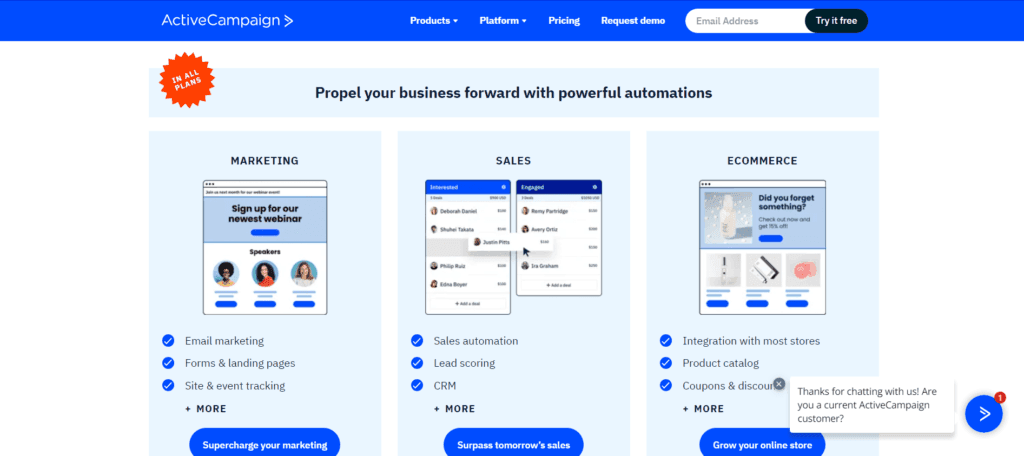
Features:
- Site & Event Tracking: Understand what leads are doing after they click through emails.
- Automation Map: Visualize the email journeys you’ve created and find opportunities for growth.
- Advanced Reporting: Dive deep into campaign performance, sales, automation, and more.
Pricing:
- Lite: Starting at $9/month for up to 500 subscribers.
- Plus: Starting at $49/month for advanced features.
- Enterprise: Custom pricing for businesses needing more comprehensive solutions.
Pros:
- Powerful automation capabilities.
- CRM integration that allows for sales automation.
- A plethora of integration options with other tools.
Cons:
- Steeper learning curve, especially for beginners.
- Some users have reported delays in email sending during peak times.
#8. Klaviyo

Features:
- Behavioral Targeting: Send messages based on purchasing behavior.
- ROI-based Reporting: Understand exactly how much revenue each campaign generates.
- Flow Library: Pre-built automations for various objectives.
Pricing:
- Pricing is based on the number of contacts, starting free for up to 250 contacts and scaling up accordingly.
Pros:
- Deep e-commerce integration, particularly with Shopify.
- Dynamic data blocks for highly personalized content.
- Comprehensive segmentation features.
Cons:
- Can become pricey for larger contact lists.
- Initially overwhelming with its feature-rich platform.
#9. HubSpot Email Marketing
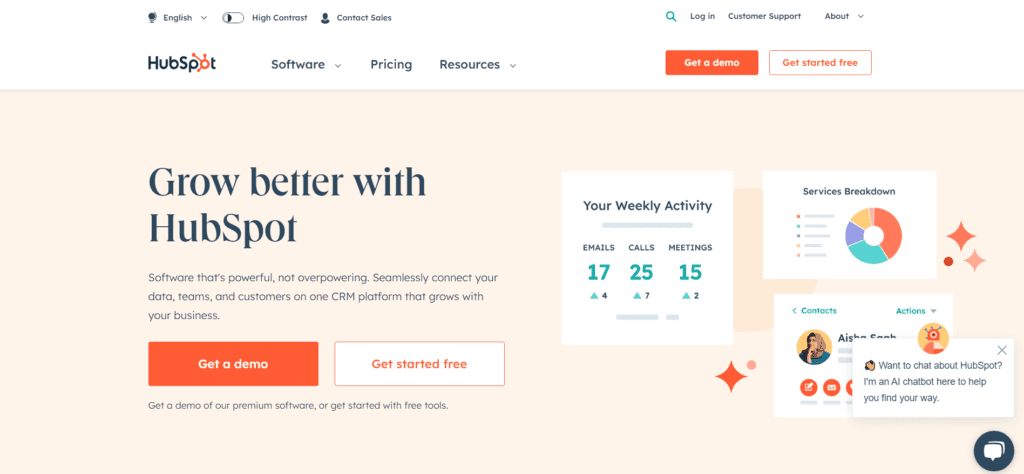
Features:
- Personalization: Tailor content to individual recipients.
- Analytics Dashboard: Comprehensive view of email performance.
- A/B Testing: Test various elements to determine optimal campaign structures.
Pricing:
- Starter: Starting at $45/month.
- Professional: $800/month.
- Enterprise: $3,200/month.
Pros:
- Seamlessly integrates with HubSpot CRM.
- Drag-and-drop editor simplifying the design process.
- Strong community and educational resources.
Cons:
- The full suite of tools can be expensive.
- Some advanced features locked behind higher tiers.
We’ve found HubSpot’s user-friendly interface particularly beneficial, as it empowers our team to create compelling and personalized emails without needing extensive technical knowledge.
Elie Steinbock
Inbox Zero
#10. Omnisend
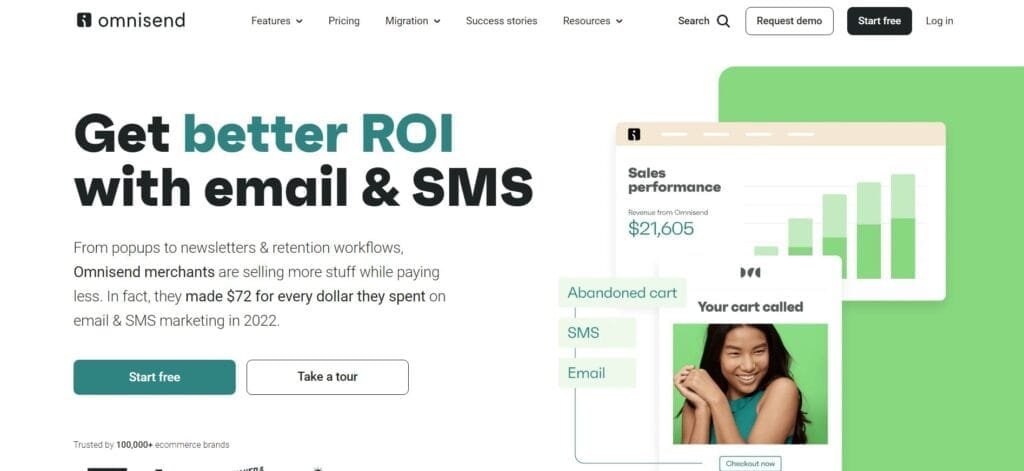
Features:
- Automated Email Sequences: Tailor messages based on user behavior.
- Segmentation: Deep dive into list segmentation to target effectively.
- Website Interaction Tracking: Monitor how email recipients interact with your site.
Pricing:
- Free Plan: Basic email campaigns.
- Standard: Starting at $16/month.
- Pro: Starting at $99/month with advanced features.
Pros:
- SMS and push notification capabilities.
- Easily integrated with e-commerce platforms.
- Visual automation builder for ease of use.
Cons:
- Limited features on the free plan.
- The interface may be less intuitive for some users.
#11. Iterable

Features:
- Multi-Channel User Engagement: Engage users through email, push, SMS, and more.
- Dynamic Personalization: Adjust emails based on user data.
- A/B Testing: Optimize campaigns through testing.
Pricing:
- Custom pricing based on individual business needs.
Pros:
- Integration with a wide range of platforms.
- Strong focus on user lifecycle campaigns.
- Dedicated customer success manager for premium accounts.
Cons:
- Pricing transparency could be better.
- Some features require manual setup.
#12. Drip

Features:
- Visual Workflow: Craft customer journeys with a visual interface.
- Tagging & Shared Segments: Easily categorize and target your audience.
- Revenue Attribution: See which campaigns are driving sales.
Pricing:
- Pricing starts at $19/month for up to 500 contacts.
Pros:
- Deep integration capabilities with e-commerce platforms.
- Event tracking helps in understanding user actions.
- Flexible API for custom needs.
Cons:
- Lacks some features for large enterprises.
- The learning curve for newcomers.
#13. Moosend

Features:
- Advanced List Segmentation: Create highly targeted campaigns.
- Email Automation Templates: Get started quickly with pre-made templates.
- Real-time Analytics: Track performance in real-time.
Pricing:
- Free for up to 1,000 subscribers.
- Pro plans start at $8/month.
Pros:
- User-friendly interface.
- No caps on emails even in the free plan.
- Easily integrated with popular CMS platforms.
Cons:
- Limited template designs.
- Fewer advanced automation features than competitors.
#14. ConvertKit

Features:
- Visual Automations: Easily visualize and build email funnels.
- Personalized Content: Send targeted content to segmented lists.
- Built for Creators: Special tools and templates for online creators.
Pricing:
- Free plan for up to 1,000 subscribers.
- Paid plans starting at $29/month.
Pros:
- Simplified interface, great for solo entrepreneurs.
- Specific features for bloggers and content creators.
- Direct integration with many e-commerce and course platforms.
Cons:
- Limited email templating options.
- No SMS or multi-channel capabilities.
#15. Sender

Features:
- Drag & Drop Editor: Easily design emails without coding.
- Push Notifications: Engage users even when they aren’t in their inboxes.
- Subscriber Management: Keep your list organized and healthy.
Pricing:
- Free for up to 2,500 subscribers.
- Paid plans start at $11.99/month.
Pros:
- Affordable pricing structure.
- Intuitive user interface.
- Robust API for integrations.
Cons:
- Limited advanced automations.
- Reporting could be more detailed.
A/B Testing and its Influence on Email Campaigns
A/B testing, often called split testing, is an experimental approach to optimizing email campaigns. It involves sending two versions of an email to different subsets of your audience to see which one performs better based on a specific metric, such as click-through rate or conversion.
#1. Setting up an A/B Test
Selecting Variables to Test: To conduct an effective A/B test, choose one element at a time to change and test. This could be the subject line, the email’s main image, or the wording of your call-to-action.
Deciding on Test Groups: Segment your email list into two groups: one will receive version A (the control), and the other will receive version B (the variant). Ensuring these groups are randomized guarantees the validity of the test results.
Analyzing Results: After your emails have been sent, analyze the results. Use statistical analysis to determine if the difference in performance between the two versions is significant.
#2. Common Elements to A/B Test
Subject Lines: The first thing subscribers see. Testing playful vs. serious tones, or including emojis vs. plain text, can yield valuable insights.
Email Content: Experiment with different content formats, such as text-heavy emails versus ones driven by images or videos.
CTA Buttons: Test different colors, wording, or button sizes to see which garners more clicks.
Send Times: Determining the optimal time to send emails to your audience can drastically impact open and conversion rates.
#3. Interpreting A/B Testing Results
Statistical Significance: Ensure that your test results are statistically significant. This means that the difference in performance between versions A and B isn’t just due to chance.
Translating Results into Actionable Insights: Beyond just noting which version “won,” delve into why it might have outperformed the other. These insights can inform broader email strategy adjustments and improvements.
Mailchimp makes it easy to test different elements of my emails, like the subject line or call-to-action, to see what resonates most with my audience. This helps me continually optimize my campaigns for better results.
Garrett
Founder- WeLoveDoodles
CRM Integration
Managing Subscriber Data: Integrating your email platform with a Customer Relationship Management (CRM) system allows you to keep subscriber data updated and organized.
Personalizing Email Content: With rich CRM data, emails can be personalized based on a subscriber’s past interactions, preferences, and purchase history, making each email feel tailor-made.
#4. Integration with Web Analytics Tools
Measuring Email-driven Website Traffic: Integrating tools like Google Analytics lets you track subscribers from the email click to website interaction, providing insight into their post-click behavior.
Understanding Post-click Behavior: See which pages subscribers visit after clicking on your email, how long they stay, and whether they convert, allowing for a richer understanding of their interests and behavior.
#5. Social Media Integration
Promoting Email Content on Social Platforms: Share highlights or exclusive offers from your emails on social media to extend their reach and drive sign-ups.
Tracking Social Referrals to Email Sign-ups: Understand which social platforms are driving the most subscribers to your email list, helping refine your multi-channel marketing strategy.
We set up workflows to automate repetitive tasks, such as sending follow-up emails or nurturing leads over time. This not only saves us a significant amount of time but also ensures we’re consistent and timely in our communications.
Jennifer Parker
Director of Marketing- JDP Innovations
Best Practices for Optimizing Email Campaigns using Analytics
#1. Responsive Design
In an era where a significant portion of emails are opened on mobile devices, ensuring that your email design is mobile-friendly is not just best practice—it’s essential.
Importance of Mobile Optimization: With over half of emails now opened on mobile devices, responsive design isn’t optional. An email that doesn’t render properly on mobile could lead to lower engagement rates or even unsubscribes.
Tools and Tactics to Ensure Responsiveness: Modern email marketing platforms offer templates that are inherently responsive. Tools like Litmus or Email on Acid can also test how emails look across various devices and platforms.
#2. Personalization and Automation
Using Subscriber Data to Tailor Emails: Generic emails are a thing of the past. With the wealth of data at a marketer’s fingertips, emails can and should be tailored to individual subscribers. From using a subscriber’s name to offering product recommendations based on past behavior, personalization can significantly boost engagement.
Setting Up Triggered Emails Based on Behavior: Triggered emails, like cart abandonment reminders or post-purchase follow-ups, show subscribers that you’re paying attention and can dramatically increase conversions.
By automating repetitive tasks, businesses can save time, streamline operations, and focus on more strategic aspects of their marketing efforts.
Jens Kleinholz
CEO- Sir-Apfelot
#3. Regularly Reviewing and Adapting
Importance of Continuous Learning: The digital landscape is always evolving, and what worked yesterday might not work tomorrow. Regularly reviewing email campaign data allows for ongoing learning and adaptation.
Adapting Strategies Based on Performance Data: Beyond just reviewing, it’s crucial to take insights from your analytics and apply them. If one type of email consistently underperforms, consider adjusting or even eliminating it.
#4. Ensuring Deliverability
The Significance of SPF, DKIM, and DMARC: These are email authentication methods that help prevent spoofing and phishing. Ensuring these are set up correctly can improve your email deliverability rates.
Practices to Avoid Landing in Spam: Beyond authentication, maintaining a clean email list, avoiding spam-trigger words in your content, and ensuring your emails are wanted (via double opt-ins and regular engagement) can keep you out of the dreaded spam folder.
Potential Challenges in Email Analytics
#1. Data Accuracy and Reliability
Ensuring Data Integrity: Incorrect or inconsistent data can lead to misguided decisions. Regular audits, consistent naming conventions, and using reliable data sources are ways to maintain data integrity.
Managing Anomalies in Data: Sometimes, spikes or dips in metrics might be caused by external factors and not represent a real trend. It’s essential to identify and account for these when analyzing data.
#2. Over-reliance on Data
The Balance Between Data-driven and Intuitive Decision-making: While data provides invaluable insights, it shouldn’t stifle intuition and creativity. It’s about striking the right balance between what the numbers tell you and innovative, outside-the-box thinking.
#3. Data Privacy Concerns
GDPR and Other Global Privacy Regulations: With regulations like the General Data Protection Regulation (GDPR) in the European Union, it’s more critical than ever to handle subscriber data responsibly.
Best Practices for Data Collection and Storage: Always get explicit consent before collecting data. Store data securely, and ensure subscribers can easily access, modify, or delete their information upon request.
Wrapping it up
In the dynamic realm of digital marketing, leveraging email analytics is pivotal for any business’s success. These tools don’t merely track metrics; they offer invaluable insights into customer behavior, allowing brands to tailor their strategies effectively. Understanding these analytics is essential, turning email campaigns from mere broadcasts into meaningful, two-way conversations with the audience.
As we’ve dissected, email analytics illuminates the path, helping fine-tune campaigns for maximum impact. However, the journey doesn’t end with data; it’s crucial to balance insights with creativity. Moving forward, harness these tools but let innovation lead the way. Remember, in an ocean of data, sometimes it’s the intuitive, human touch that resonates the most.
Read Next:





















